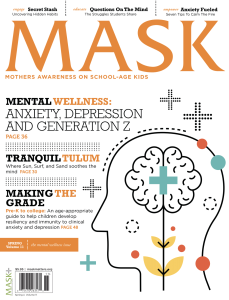
Magazines to Consider Adding to Your MASK Library
-
Anorexia is the third most common chronic illness among adolescents.
-
95% of those who have eating disorders are between the ages of 12 and 25.8.
-
The mortality rate associated with anorexia nervosa is 12 times higher than the death rate associated with all causes of death for females 15-24 years old.
-
81% of 10 year olds are afraid of being fat.
-
Up to 24 million people of all ages and genders suffer from an eating disorder (anorexia, bulimia and binge eating disorder) in the U.S. Source: Anorexia Nervosa and Associated Disorders, Inc.
Eating disorders are one of the silent killers affecting our youth. Culture and American medicine have a huge impact. Kids are exposed to thousands of hours of what the media considers to be the “perfect” body. Kids then equate these images with personal happiness, love and financial success. It is really no wonder young people turn to weight loss as a way to solve their problems.
In the United States, 5-10 million girls and women and 1 million boys and men struggle with eating disorders. Half of adolescent females report dieting before the age of 14. Children as young as 6 years old are being diagnosed with eating disorders. They are occurring more frequently in ages 6-12. 50-75% of preteen girls are dieting. Girls who diet prior to age 14 are eight times more likely to develop eating disorders. Although this has been a disorder affecting young girls and women, males are also starting to adopt this behavior. The key to preventing always comes to parents being aware of the possibilities, understanding the warning signs and keeping contact communication with their children.
 Contributing factors to eating disorders
Contributing factors to eating disorders
- Abuse
- Dysfunctional/chaotic family systems
- Perfectionist & obsessional personality traits
- Peer influence
- Low self esteem
- Helplessness and need for control
- Social anxiety and lack of social skills
- Family history of Eating Disorder
 Warning signs
Warning signs
- Weight loss
- Intense fear of being overweight: Preoccupied with thinness, scales and mirrors
- Preoccupied with dieting and food
- Eating little
- Bathroom breaks: bathroom use during/after meals suggest vomiting to purge calories
- Excessive caffeine use
- Social withdrawal
- Onset of hyperactivity – fidgeting, excessive exercise
- Skin – hair problems – dry skin , dry hair, hair loss & fine hair growth
- Swollen salivary glands – “chipmunk cheeks”
- Mood changes, anxiety, depression, obsessions
- Intolerant of cold
- Count calories & fat grams
- Preoccupied with “healthy eating” fitness exercise
- Fear foods
- Excessive gum chewing – to curb hunger
- Medical Complications of Eating Disorders in Children
- Malnutrition
- Stunted growth
- Bone loss
- Decreased brain mass and function
- Decreased organ function
- Reproductive damage
- Heart damage or decreased function
- Changes in body chemistry & metabolism
 What you can do
What you can do
- Take action. The earlier the problem is addressed the greater the chance of a positive outcome
- Healthy communication is vital. Talking with the child in a non-threatening manner, expressing love and concern may help to acknowledge the behavior and begin to deal with it.
- Parents should seek professional help from a healthcare professional who specialized in Eating Disorders. They can evaluate the situation, then make recommendations for treatment
 Promote “Healthy Eating”
Promote “Healthy Eating”
- Demonstrate balance in eating. Convey that all foods can be eaten and enjoyed in moderation. Do not give foods “Good or Bad labels.”
- Demonstrate balance in exercise. Engage in physical activities for recreation and fun to show a healthy lifestyle, not for weight loss.
- Don’t use food either as a punishment or a reward.
- Help children to develop self esteem from their positive qualities. Not exclusively in their appearance.
To read more on this topic click here










